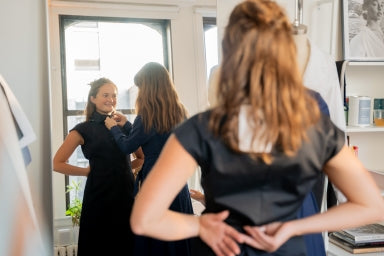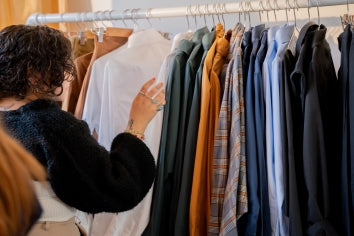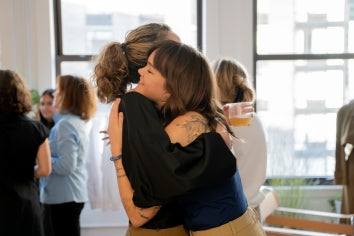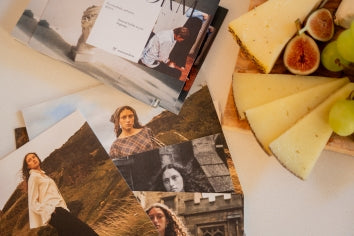“A shirt is a word, a pair of pants is another word, and with pair of shoes it's a paragraph.”
This is the clever motto told by Colton, founder of styling company Cuniform, which specializes in curating wardrobes that are grounded in ethical, sustainable, and thoughtful consumption. Though not a fashionista himself, Colton believes that the relationships he has with people by being in the industry are just as meaningful as the clothes themselves. He says his fulfillment comes from educating his clients on the impact that clothes have, guiding them to make conscious, informed, and intentional decisions about their closet.
“I believe fashion is a language,”
he goes on to explain. “You can tell a story when you put on a piece. I can ask myself, am I feeling vulnerable? Am I feeling sexy? Am I feeling nervous? These are all questions I get to answer when I get dressed in the morning.”
As one often does when sharing one’s perspective, Colton says that his motto might be a bit cliché. I assure him that it is far from that. Perhaps what is more cliché is the horribly out of date, evangelical preaching that our bodies are temples meant to be protected. Instead, as Colton suggests, I like to think that we are more akin to a blank sheet of paper, waiting to be written on with the pen that is our clothing; they can hang on our frames like standing on an empty soapbox, waiting to be heard. Indeed, the items in our wardrobe sum together to create the lexicon of our unique identities—a concept that seems so obvious, yet difficult to digest. We like to think, or so we’ve been told, that fashion is made for fashion lovers, that only the drama queens, the materialists, and the “superficial,” as Pam, one of GRAMMAR’s loyal customers puts it, can participate. However, my conversations with various designers, stylists, customers, and even Althea herself, have shown me just how distinct each of our relationships with fashion are, uniquely shaped by one’s culture, identity, and values––a curious paradox of being universally accessible yet infinitely individual at the same time. Such perspectives I believe shed an important light on the fact that fashion is closer to a piece of technology––a tool, an instrument that can assist us through life––than it is mere embellishment. It is a way of navigating and understanding the world, just as language does.
Hence, in what ways does fashion function as a tool, a method, and a means to understanding our world? How does it manifest itself on personal, communal, and cultural levels?
In this part of my ethnography, I aim to answer such questions because I believe that it is only when we can understand fashion at large that we can begin to understand how meaning and emotion becomes tied to clothing.
The concept of fashion, in colloquial terms, is often coupled with the definition of “fashionable;” but how can we define it for our terms? Many commonly say that Americans are notoriously unfashionable, that we are consistently underdressed, lacking in the self-care routines which have become the bare minimum in other countries. Others poke fun at our habits of wearing Lululemon on the first date or distressed denim out at a bar. Even within our own communities, we are quick to rank fashion based on class and geographical region, with city people looking down upon the out-of-fashion outfits of average suburban residents, and suburbanites deriding city folk for their strange or impractical looks. After living in the city for almost a year, I too have fallen victim to being overly judgmental, despite having grown up in a small Washington town in my entire life, where hiking boots are considered acceptable interview attire and Patagonia pullovers can be spotted on nearly every corner. Perhaps it was our shared understanding of Pacific Northwest culture that I instantly felt a connection with Colton, whose company is based in Seattle, only an hour’s drive from my childhood hometown. Upon our first meeting, he shared with me the culture shock he experienced moving across the country, after having worked in retail and boutiques in New York City for years, alluding to the epidemic of athleisure that runs rampant in the beautiful Evergreen state.
“At first I didn’t get it,” Colton tells me. “The North Faces, the Patagonias...but now I understand it, and it makes sense.” His experiences working with a diverse range of clients through Cuniform––from students, baristas, and trans folks, to CEOs, lawyers, and celebrities––has allowed him to see the extent to which personal lifestyle choices, hobbies, financial circumstances, etc. influence how people build their wardrobes. Hence, although his goal is to educate all his clients to invest in quality, sustainable pieces––helping clients let go of careless or unethical purchases through a process known as “wardrobe auditing”––he also acknowledges that people have different needs and priorities. Further, he proudly insists that “having empathy” and “truly getting to know people through their closets” is the most exciting—and important—part of making this process successful. And thus, for his Seattle-based clients, perhaps a more “West Coast chic'' aesthetic is best suited for the weather, environment, and the colloquial definition of formal and casual wear.
We might say that fashion varies across the states as different accents do; America is an anthology of regional history, culture, and customs.
Similarly, fashion operates on an individual level, telling the stories of what we value and how we wish to be perceived.
One of GRAMMAR’s customers whom I spoke with, Pam, admits that her style is very reflective of her lifestyle and experiences, heavily informed by “all the lives [she’s] lived”. She began as a college professor at University of California, Berkeley before making the switch to a foreign policy analyst in Washington D.C. After many years, she returned to her role in academia and teaching literature at Berkeley, as well as editing the university’s publications. Now 72, residing in quiet, sunny California, she owns nine GRAMMAR shirts among other pieces, all of which she believes fulfill her essential wardrobe needs: “tailored, classic, and feminine.” However, she also shares that with age and experience, comes an inevitable evolution of her personal style.
For Pam, style can be incredibly career-driven, especially as a woman. “There’s this idea that being fashionable means you’re superficial, and I don’t like that. I want to be able to be fashionable, while still being perceived as intellectual.” She describes the hyper-professional, serious work culture that she felt while working in D.C. that left little room for creative expression, and the constraints of common stereotypes surrounding women in the field, such as the well-dressed, feminine-presenting woman who flirts with her male coworkers. Conversely, she says that being back in a university environment allowed her more freedom to wear things that are more flowy than a stuffy blazer, for example, or that have a bit of an artistic edge. Still, as a professor, being perceived as a skilled intellectual in her field remains a priority. “There’s that and well, I’m also old,” She laughs, waving her arms in the air in an attempt to reveal wrinkling skin (there were no perceptible wrinkles).
I giggle along with her, beginning to understand what she means when she shares that, while she considers herself someone who could be sitting at a runway show, she wouldn’t be running to the nearest store to purchase those trends. Hence, I ask her, “What do you look for, then, when you buy clothes? Is there anything special you pay attention to?”
“I want a balance between being fashionable and being, well, myself, while also still being taken seriously. I think that’s hard to find, and it’s one of the reasons I buy GRAMMAR.”
For Pam, it’s the “pointiness” of a collar, a perfectly cinched waist, a slightly dropped shoulder, the minute details in GRAMMAR’s incredibly simple (some might even say basic) designs that keeps her clicking the “add to cart” button. Though it’s not my personal style, I resonate with her perspective on wanting to counter traditional notions of being fashionable, which are often misunderstood as inherently feminine or innately seductive.
We often hear that fashion is about self-expression, that we should dress for no one but ourselves. While I believe this statement to be true, Pam’s experiences speak to the reality that fashion is equally about how others perceive us, and making choices based on how we wish to be perceived. Another woman whom I spoke with, Holly, another one of GRAMMAR’s loyal customers, as well as Althea’s childhood best friend, shares a similar insight. Holly is not only a fashion lover but is fluent in the industry, having worked in many sectors such as e-commerce and wholesale for luxury brands such as Tiffany and Coach. Like Pam, Holly explains how her work environment shapes her style. “Working in a creative environment means that I can basically wear whatever,” she explains. “It’s something that makes going into work enjoyable.” For Holly, the office is her haven of sorts, a playground for her to experiment, to express herself with the comfort of being supported by others who share her same passion. The thought of one’s 9-to-5 being a site for creative expression is like a warm embrace to my anxious heart, a spoonful of sugar to the recurring nightmares I have about being trapped in sweat-stain covered blouses and unforgiving trousers the second I get my hands on a diploma.
“My biggest fear is corporate wear,” I admit. “Even within that sphere [of dressing], there’s always so much space for judgment.” I think back to a summer job I had where I was told that I was not allowed to wear my Jade buddha necklace, a token of love and pride for my Chinese heritage. Something that is considered appropriate for any formal occasion back in my home country, often received as anniversary or graduation gifts, was apparently not accepted there.
“Oh, I completely get it,” Holly interjects. “But I think if you’re in that type of environment then you can very clearly see their values, and it’s perfectly fine if you don’t align with them.” Her words are comforting, her expertise in her field shining through her perfectly symmetrical smile, and I try as hard as I can to have faith in what she says. Like Colton, Holly begins her mornings with asking herself the questions,
“What story do I want to tell today? Who do I want to be today?”
I too, share this same mindset: two coffees in, with the lingering sting of baking soda toothpaste on my gums, I position myself with my feet shoulder-width apart, hands on my hips in front of my closet every single morning, practically foaming at the mouth in anticipation of what I will compose. Some might call us self-centered, or perhaps even superficial, and yet, as Holly notes, “What you wear can say so much. I love being able to look at strangers, notice the details in what they’re wearing and think, ‘They look like an interesting person. I would love to get to know them.’”
Thus, answering these morning questions for her is more than just simply playing dress-up for her own fulfillment, but also acknowledging the power clothes have on others, taking part in the larger network of personal expression that, obvious or not, is present all the time, everywhere. Perhaps one might argue that fashion behaves like a two-way mirror, allowing us the power to showcase the way we view ourselves and others.
We are all storytellers,
equally equipped to both write our own stories and read another's.
At the end of my initial meeting with Holly, she says plainly, “Whether you like it or not, you are making choices every day, and even if that choice means putting in the least amount of effort to communicate, it’s still communicating.”
Indeed, regardless of where we identify on the scale of “I grabbed this shirt in the dark and put it on” to “I have Dior’s new collection launch date set as a reminder in my phone”, we all participate in this larger system of fashion, which is ultimately about communicating our values, morals, and personhood. For Colton, the joy of clothing comes from dressing others more than dressing himself. As for his own closet, his curation is informed by his experience in luxury fashion, the city where he lives, and his passion for the environment. For Pam, her style reflects decades of being a woman in academia and politics, as well as how she embraces femininity and aging. She says, “If you’re buying something to put on someone else’s image rather than your own, that is not how you do fashion.” It should not matter whether someone else would consider a piece to be “in style;” if it does not speak to you and your values, then, put simply, what’s the point? There is no “in style,” only styles. Similarly, I would argue that there is no such thing as fashionable or unfashionable, only fashion. Different opinions, tastes, and aesthetics neither fall on a spectrum of good or bad, but rather make up all the dialects of the language of how we communicate who we are. Perhaps the cherry on top of it all is, whether we wish to participate or not, there is no option for “opting out.”








